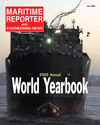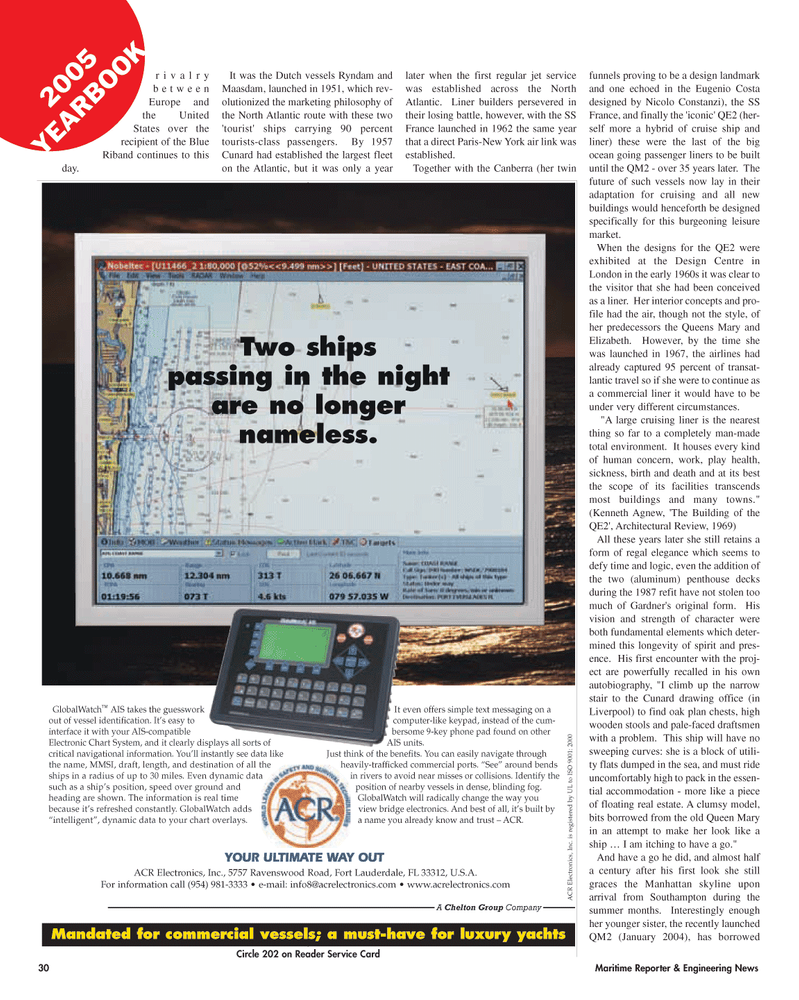
Page 30: of Maritime Reporter Magazine (June 2005)
Annual World Yearbook
Read this page in Pdf, Flash or Html5 edition of June 2005 Maritime Reporter Magazine
30 Maritime Reporter & Engineering News rivalry between
Europe and the United
States over the recipient of the Blue
Riband continues to this day.
It was the Dutch vessels Ryndam and
Maasdam, launched in 1951, which rev- olutionized the marketing philosophy of the North Atlantic route with these two 'tourist' ships carrying 90 percent tourists-class passengers. By 1957
Cunard had established the largest fleet on the Atlantic, but it was only a year later when the first regular jet service was established across the North
Atlantic. Liner builders persevered in their losing battle, however, with the SS
France launched in 1962 the same year that a direct Paris-New York air link was established.
Together with the Canberra (her twin funnels proving to be a design landmark and one echoed in the Eugenio Costa designed by Nicolo Constanzi), the SS
France, and finally the 'iconic' QE2 (her- self more a hybrid of cruise ship and liner) these were the last of the big ocean going passenger liners to be built until the QM2 - over 35 years later. The future of such vessels now lay in their adaptation for cruising and all new buildings would henceforth be designed specifically for this burgeoning leisure market.
When the designs for the QE2 were exhibited at the Design Centre in
London in the early 1960s it was clear to the visitor that she had been conceived as a liner. Her interior concepts and pro- file had the air, though not the style, of her predecessors the Queens Mary and
Elizabeth. However, by the time she was launched in 1967, the airlines had already captured 95 percent of transat- lantic travel so if she were to continue as a commercial liner it would have to be under very different circumstances. "A large cruising liner is the nearest thing so far to a completely man-made total environment. It houses every kind of human concern, work, play health, sickness, birth and death and at its best the scope of its facilities transcends most buildings and many towns." (Kenneth Agnew, 'The Building of the
QE2', Architectural Review, 1969)
All these years later she still retains a form of regal elegance which seems to defy time and logic, even the addition of the two (aluminum) penthouse decks during the 1987 refit have not stolen too much of Gardner's original form. His vision and strength of character were both fundamental elements which deter- mined this longevity of spirit and pres- ence. His first encounter with the proj- ect are powerfully recalled in his own autobiography, "I climb up the narrow stair to the Cunard drawing office (in
Liverpool) to find oak plan chests, high wooden stools and pale-faced draftsmen with a problem. This ship will have no sweeping curves: she is a block of utili- ty flats dumped in the sea, and must ride uncomfortably high to pack in the essen- tial accommodation - more like a piece of floating real estate. A clumsy model, bits borrowed from the old Queen Mary in an attempt to make her look like a ship … I am itching to have a go."
And have a go he did, and almost half a century after his first look she still graces the Manhattan skyline upon arrival from Southampton during the summer months. Interestingly enough her younger sister, the recently launched
QM2 (January 2004), has borrowed
Circle 202 on Reader Service Card
GlobalWatch
TM
AIS takes the guesswork out of vessel identification. It’s easy to interface it with your AIS-compatible
Electronic Chart System, and it clearly displays all sorts of critical navigational information. You’ll instantly see data like the name, MMSI, draft, length, and destination of all the ships in a radius of up to 30 miles. Even dynamic data such as a ship’s position, speed over ground and heading are shown. The information is real time because it’s refreshed constantly. GlobalWatch adds “intelligent”, dynamic data to your chart overlays.
It even offers simple text messaging on a computer-like keypad, instead of the cum- bersome 9-key phone pad found on other
AIS units.
Just think of the benefits. You can easily navigate through heavily-trafficked commercial ports. “See” around bends in rivers to avoid near misses or collisions. Identify the position of nearby vessels in dense, blinding fog.
GlobalWatch will radically change the way you view bridge electronics. And best of all, it’s built by a name you already know and trust – ACR.
YOUR ULTIMATE WAY OUT
ACR Electr onics, Inc. is r egister ed by UL to ISO 9001: 2000
A Chelton Group Company
ACR Electronics, Inc., 5757 Ravenswood Road, Fort Lauderdale, FL 33312, U.S.A.
For information call (954) 981-3333 • e-mail: [email protected] • www.acrelectronics.com
Two ships passing in the night are no longer nameless.
Mandated for commercial vessels; a must-have for luxury yachts 2005
YEARBOOK
MR JUNE 2005 #4 (25-32).qxd 6/2/2005 7:06 PM Page 30

 29
29

 31
31
